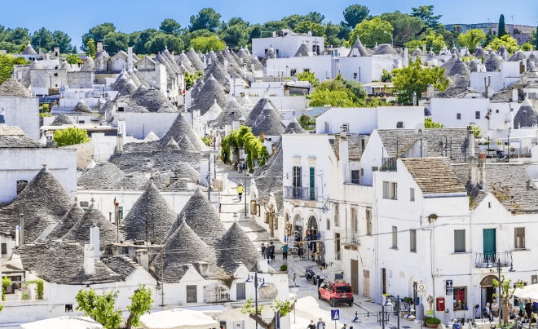
The surge in tourism across Italy this year coincided with scorching summer temperatures. Having worked there 20 years ago, I was well aware that August was a definite no-go, as the entire nation embarked on a holiday. Therefore, I’ve adjusted my visits to the late season, when tourist numbers are still present but at a more manageable density, especially if you venture off the beaten path. Italy, in any region, remains captivating, enjoyable, and delectable in its own unique way.
READ: The Most European-Style Cities In America
This year, I chose to head south in early November, ensuring milder weather as temperatures began to cool in the north. My destination? “The Heel of the Boot”—Puglia (POO-li-ah), or Apulia in English.
Italy
Our journey began at Leonardo da Vinci–Fiumicino Airport, from where we took the express train to Rome’s Termini Station for a high-speed train south to Bari, the capital of Puglia.
Puglia boasts the longest coastline of all mainland regions in Italy, with shores on the Adriatic Sea and a Mediterranean climate. It holds the top spot in wine production and contributes significantly to the nation’s olive oil production. With human settlement dating back to Neolithic times and Greek colonization in the eighth century B.C., Puglia’s history is rich, including its absorption into the Roman Empire. While the region experienced its peak wealth and prestige in the 17th and 18th centuries, it has long been associated with poverty in more modern times. The rise-and-fall-and-rise-again story of Puglia is truly fascinating and worth exploring.
Bari, the regional capital, offers a picturesque seaside promenade, numerous historical landmarks, including theaters, and the intricate Bari Vecchia—the old city—capturing our attention.
For me, the initial allure lies in the local cuisine. The regional dishes feature abundant meat options alongside delightful and simple vegetarian meals. Focaccia barese stands out with its crisp, olive-oil-soaked crust, topped with crushed tomatoes and, perhaps, a few olives. Popular places like Panificio Fiore and Panificio Santa Rita draw lines of locals down the cobblestone streets. Spice enthusiasts should savor the spaghetti all’assassina, cooked dry in a hot iron pan for a char and crunch, with garlic, olive oil, chili pepper, and finished in tomato sauce. Fresh octopus sandwiches at Mastro Ciccio, served with Peroni on tap, are a must-try.
A visit to the Strada delle Orecchiette (the street of “little-ears” pasta) is recommended, where local grandmothers (le nonne) craft traditional pasta by hand. Opt for the thumbnail-sized variety, avoiding the large, multicolored clamshell creations aimed at tourists. Engage with the makers, as each one is someone’s grandma. Don’t just take photos; strike up a conversation. And be sure to order orecchiette con le cime di rapa (pasta with broccoli rabe) at a local trattoria.
Bari’s Basilica of Saint Nicholas, dating back to the 11th century, holds significance for pilgrims from both the Roman Catholic and Orthodox traditions. The remains of Saint Nicholas, who served as a bishop during the late Roman Empire, were brought to Bari by crusaders from the Byzantine Empire, now part of Turkey, during the Seljuk Turks’ rule.